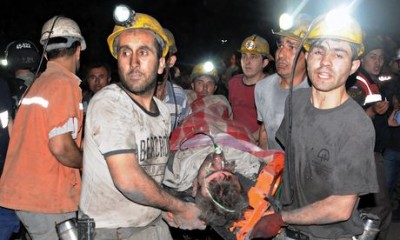Turkish Mine Explosion, Predicted in 2010
2010 Report Warned Dangerous Conditions Could Produce “Disaster”

Turkish police used tear gas, rubber bullets and water cannons against thousands of protesters Friday in the city of Soma, the location of a deadly mine explosion that has killed nearly 300 workers. Demonstrations have erupted throughout the country, as more details emerge exposing the disaster as preventable and caused by a lack of basic safety procedures.
The official death toll from the mine fire that occurred on Tuesday now stands at 292. Government and company officials report that up to 18 miners are still unaccounted for and may be trapped in the mine, while workers have said the true number could be far higher. Already, the Soma “massacre” ranks as the deadliest mine disaster in Turkish history.
The Turkish government of Prime Minister Recep Tayyip Erdogan and the ruling Justice and Development Party (AKP) have responded to growing popular outrage with repression and riot police. (Video of demonstrators confronting riot police in Soma can be found here.)
Protests have been fueled by video and images showing Edorgan himself slapping one protester, who was subsequently beaten by police. An Erdogan aide has also been photographed kicking a protester on the ground.
Warnings about the dangerous conditions in the Soma mine have existed for years. In 2010, the Chamber of Architects and Engineers (TMMOB) produced a 152-page report, “Work Accidents in Mines,” that documented specific safety concerns that made a disastrous accident likely.
According to Hurriyet Daily News, the report concluded, “no production should be made [at the Soma mine] before the necessary research has been completed. Carrying out production with the lack of experience might lead to disaster.” The mine was particularly dangerous because of the high levels of methane, the TMMOB report concluded.
One worker told Halk TV on Friday, “The machines were whistling for two years. I knew the reason. They are digging areas that had methane where they should not have dug.” As for supposed safety inspections, the miner said, “Inspectors came, but they only reviewed the main tunnels. They didn’t look at the details.” Hurriyet writes that the TMMOB report also “draws attention to the lack of any alternative routes for breathing or escaping, which made the rescue of the workers almost impossible in case of an accident.”
“The ventilation in the mine pit is adversely affected since workers can’t be evacuated from the mine urgently and safely,” the report found. “Dangerous gasses cannot be tracked at any time, necessary measures cannot be taken at the right time and evacuation of the mine cannot be maintained immediately.”
On Friday, company officials acknowledged that there was no refuge chamber for miners to access in the case of a fire. Such a chamber existed during an earlier phase of production, but when the mining was extended deeper underground nothing was constructed for the new location. The owners of the mine have claimed that they were in the process of building a new chamber, and that these chambers are not required by law.
The precise cause of the fire on Tuesday has not been definitely determined. Officials initially said a power transformer exploded, cutting off electricity to elevators and suffocating hundreds of miners, who likely died of carbon monoxide poisoning. In order to cut costs, Soma manufactured its own transformers.
However, plant manager Akin Celik has since said that the cause of the fire remains unknown. “There is no negligence of ours in this incident,” he claimed in a press conference on Friday.
The manager’s retraction came after a statement from a local branch of the Chamber of Electrical Engineers called the disaster “murder,” stating that it was “not caused by an electrical situation as presented to the public.” The chamber reported that inspections after the explosion revealed “that the systems to sense poisonous and explosive gases in the mine and the systems to manage the air systems were insufficient and old.”
The engineers argued that the deaths were caused by a coal fire deep underground, with flames and smoke spread through the mine’s ventilation system.
Since the Soma mine was fully privatized in 2005, the company that owns the mine, Soma Komur Isletmeleri, boasted of having slashed costs by more than 80 percent, from $130 per ton to under $24 per ton. Miners are paid poverty wages, operations sped up and safety neglected in order to funnel profits to the company’s investors.
The disaster has exposed the brutal exploitation of the Turkish working class as a whole and miners in particular. Turkey has the highest rate of mine deaths in the world, with an average of 7.22 fatalities per million tons of coal. According to the Worker Health and Safety Assembly, 1,235 workers in all sectors were killed in 2013 and another 396 in 2014 so far.

